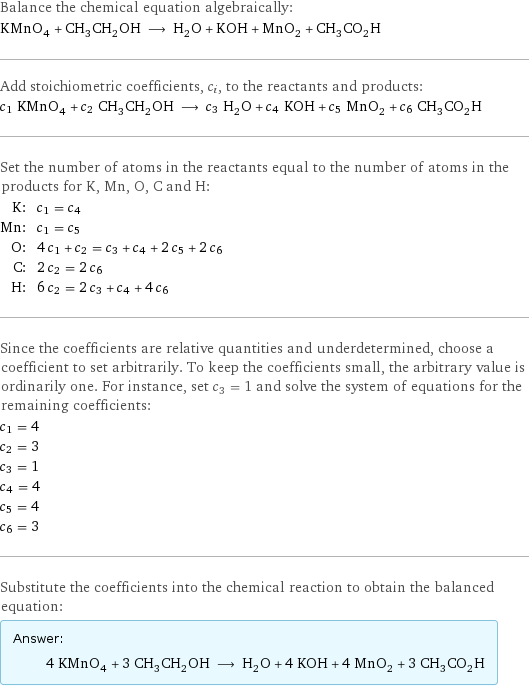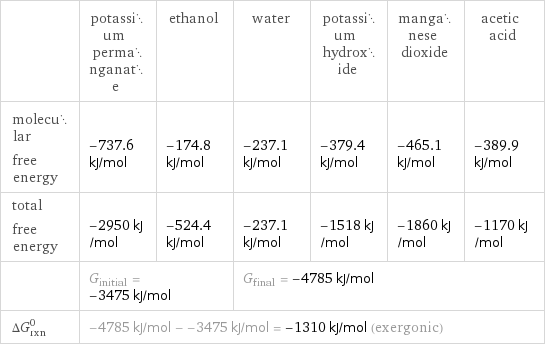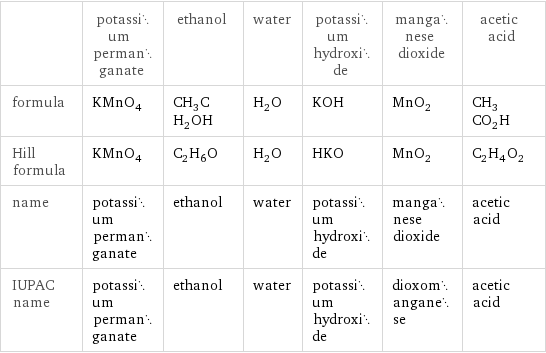Input interpretation

KMnO_4 potassium permanganate + CH_3CH_2OH ethanol ⟶ H_2O water + KOH potassium hydroxide + MnO_2 manganese dioxide + CH_3CO_2H acetic acid
Balanced equation

Balance the chemical equation algebraically: KMnO_4 + CH_3CH_2OH ⟶ H_2O + KOH + MnO_2 + CH_3CO_2H Add stoichiometric coefficients, c_i, to the reactants and products: c_1 KMnO_4 + c_2 CH_3CH_2OH ⟶ c_3 H_2O + c_4 KOH + c_5 MnO_2 + c_6 CH_3CO_2H Set the number of atoms in the reactants equal to the number of atoms in the products for K, Mn, O, C and H: K: | c_1 = c_4 Mn: | c_1 = c_5 O: | 4 c_1 + c_2 = c_3 + c_4 + 2 c_5 + 2 c_6 C: | 2 c_2 = 2 c_6 H: | 6 c_2 = 2 c_3 + c_4 + 4 c_6 Since the coefficients are relative quantities and underdetermined, choose a coefficient to set arbitrarily. To keep the coefficients small, the arbitrary value is ordinarily one. For instance, set c_3 = 1 and solve the system of equations for the remaining coefficients: c_1 = 4 c_2 = 3 c_3 = 1 c_4 = 4 c_5 = 4 c_6 = 3 Substitute the coefficients into the chemical reaction to obtain the balanced equation: Answer: | | 4 KMnO_4 + 3 CH_3CH_2OH ⟶ H_2O + 4 KOH + 4 MnO_2 + 3 CH_3CO_2H
Structures

+ ⟶ + + +
Names

potassium permanganate + ethanol ⟶ water + potassium hydroxide + manganese dioxide + acetic acid
Reaction thermodynamics
Gibbs free energy

| potassium permanganate | ethanol | water | potassium hydroxide | manganese dioxide | acetic acid molecular free energy | -737.6 kJ/mol | -174.8 kJ/mol | -237.1 kJ/mol | -379.4 kJ/mol | -465.1 kJ/mol | -389.9 kJ/mol total free energy | -2950 kJ/mol | -524.4 kJ/mol | -237.1 kJ/mol | -1518 kJ/mol | -1860 kJ/mol | -1170 kJ/mol | G_initial = -3475 kJ/mol | | G_final = -4785 kJ/mol | | | ΔG_rxn^0 | -4785 kJ/mol - -3475 kJ/mol = -1310 kJ/mol (exergonic) | | | | |
Equilibrium constant
![Construct the equilibrium constant, K, expression for: KMnO_4 + CH_3CH_2OH ⟶ H_2O + KOH + MnO_2 + CH_3CO_2H Plan: • Balance the chemical equation. • Determine the stoichiometric numbers. • Assemble the activity expression for each chemical species. • Use the activity expressions to build the equilibrium constant expression. Write the balanced chemical equation: 4 KMnO_4 + 3 CH_3CH_2OH ⟶ H_2O + 4 KOH + 4 MnO_2 + 3 CH_3CO_2H Assign stoichiometric numbers, ν_i, using the stoichiometric coefficients, c_i, from the balanced chemical equation in the following manner: ν_i = -c_i for reactants and ν_i = c_i for products: chemical species | c_i | ν_i KMnO_4 | 4 | -4 CH_3CH_2OH | 3 | -3 H_2O | 1 | 1 KOH | 4 | 4 MnO_2 | 4 | 4 CH_3CO_2H | 3 | 3 Assemble the activity expressions accounting for the state of matter and ν_i: chemical species | c_i | ν_i | activity expression KMnO_4 | 4 | -4 | ([KMnO4])^(-4) CH_3CH_2OH | 3 | -3 | ([CH3CH2OH])^(-3) H_2O | 1 | 1 | [H2O] KOH | 4 | 4 | ([KOH])^4 MnO_2 | 4 | 4 | ([MnO2])^4 CH_3CO_2H | 3 | 3 | ([CH3CO2H])^3 The equilibrium constant symbol in the concentration basis is: K_c Mulitply the activity expressions to arrive at the K_c expression: Answer: | | K_c = ([KMnO4])^(-4) ([CH3CH2OH])^(-3) [H2O] ([KOH])^4 ([MnO2])^4 ([CH3CO2H])^3 = ([H2O] ([KOH])^4 ([MnO2])^4 ([CH3CO2H])^3)/(([KMnO4])^4 ([CH3CH2OH])^3)](../image_source/d5d1add23ac2cbc0b6533713526039e8.png)
Construct the equilibrium constant, K, expression for: KMnO_4 + CH_3CH_2OH ⟶ H_2O + KOH + MnO_2 + CH_3CO_2H Plan: • Balance the chemical equation. • Determine the stoichiometric numbers. • Assemble the activity expression for each chemical species. • Use the activity expressions to build the equilibrium constant expression. Write the balanced chemical equation: 4 KMnO_4 + 3 CH_3CH_2OH ⟶ H_2O + 4 KOH + 4 MnO_2 + 3 CH_3CO_2H Assign stoichiometric numbers, ν_i, using the stoichiometric coefficients, c_i, from the balanced chemical equation in the following manner: ν_i = -c_i for reactants and ν_i = c_i for products: chemical species | c_i | ν_i KMnO_4 | 4 | -4 CH_3CH_2OH | 3 | -3 H_2O | 1 | 1 KOH | 4 | 4 MnO_2 | 4 | 4 CH_3CO_2H | 3 | 3 Assemble the activity expressions accounting for the state of matter and ν_i: chemical species | c_i | ν_i | activity expression KMnO_4 | 4 | -4 | ([KMnO4])^(-4) CH_3CH_2OH | 3 | -3 | ([CH3CH2OH])^(-3) H_2O | 1 | 1 | [H2O] KOH | 4 | 4 | ([KOH])^4 MnO_2 | 4 | 4 | ([MnO2])^4 CH_3CO_2H | 3 | 3 | ([CH3CO2H])^3 The equilibrium constant symbol in the concentration basis is: K_c Mulitply the activity expressions to arrive at the K_c expression: Answer: | | K_c = ([KMnO4])^(-4) ([CH3CH2OH])^(-3) [H2O] ([KOH])^4 ([MnO2])^4 ([CH3CO2H])^3 = ([H2O] ([KOH])^4 ([MnO2])^4 ([CH3CO2H])^3)/(([KMnO4])^4 ([CH3CH2OH])^3)
Rate of reaction
![Construct the rate of reaction expression for: KMnO_4 + CH_3CH_2OH ⟶ H_2O + KOH + MnO_2 + CH_3CO_2H Plan: • Balance the chemical equation. • Determine the stoichiometric numbers. • Assemble the rate term for each chemical species. • Write the rate of reaction expression. Write the balanced chemical equation: 4 KMnO_4 + 3 CH_3CH_2OH ⟶ H_2O + 4 KOH + 4 MnO_2 + 3 CH_3CO_2H Assign stoichiometric numbers, ν_i, using the stoichiometric coefficients, c_i, from the balanced chemical equation in the following manner: ν_i = -c_i for reactants and ν_i = c_i for products: chemical species | c_i | ν_i KMnO_4 | 4 | -4 CH_3CH_2OH | 3 | -3 H_2O | 1 | 1 KOH | 4 | 4 MnO_2 | 4 | 4 CH_3CO_2H | 3 | 3 The rate term for each chemical species, B_i, is 1/ν_i(Δ[B_i])/(Δt) where [B_i] is the amount concentration and t is time: chemical species | c_i | ν_i | rate term KMnO_4 | 4 | -4 | -1/4 (Δ[KMnO4])/(Δt) CH_3CH_2OH | 3 | -3 | -1/3 (Δ[CH3CH2OH])/(Δt) H_2O | 1 | 1 | (Δ[H2O])/(Δt) KOH | 4 | 4 | 1/4 (Δ[KOH])/(Δt) MnO_2 | 4 | 4 | 1/4 (Δ[MnO2])/(Δt) CH_3CO_2H | 3 | 3 | 1/3 (Δ[CH3CO2H])/(Δt) (for infinitesimal rate of change, replace Δ with d) Set the rate terms equal to each other to arrive at the rate expression: Answer: | | rate = -1/4 (Δ[KMnO4])/(Δt) = -1/3 (Δ[CH3CH2OH])/(Δt) = (Δ[H2O])/(Δt) = 1/4 (Δ[KOH])/(Δt) = 1/4 (Δ[MnO2])/(Δt) = 1/3 (Δ[CH3CO2H])/(Δt) (assuming constant volume and no accumulation of intermediates or side products)](../image_source/89ad1a4e7ced42fff9f08a350add8cf0.png)
Construct the rate of reaction expression for: KMnO_4 + CH_3CH_2OH ⟶ H_2O + KOH + MnO_2 + CH_3CO_2H Plan: • Balance the chemical equation. • Determine the stoichiometric numbers. • Assemble the rate term for each chemical species. • Write the rate of reaction expression. Write the balanced chemical equation: 4 KMnO_4 + 3 CH_3CH_2OH ⟶ H_2O + 4 KOH + 4 MnO_2 + 3 CH_3CO_2H Assign stoichiometric numbers, ν_i, using the stoichiometric coefficients, c_i, from the balanced chemical equation in the following manner: ν_i = -c_i for reactants and ν_i = c_i for products: chemical species | c_i | ν_i KMnO_4 | 4 | -4 CH_3CH_2OH | 3 | -3 H_2O | 1 | 1 KOH | 4 | 4 MnO_2 | 4 | 4 CH_3CO_2H | 3 | 3 The rate term for each chemical species, B_i, is 1/ν_i(Δ[B_i])/(Δt) where [B_i] is the amount concentration and t is time: chemical species | c_i | ν_i | rate term KMnO_4 | 4 | -4 | -1/4 (Δ[KMnO4])/(Δt) CH_3CH_2OH | 3 | -3 | -1/3 (Δ[CH3CH2OH])/(Δt) H_2O | 1 | 1 | (Δ[H2O])/(Δt) KOH | 4 | 4 | 1/4 (Δ[KOH])/(Δt) MnO_2 | 4 | 4 | 1/4 (Δ[MnO2])/(Δt) CH_3CO_2H | 3 | 3 | 1/3 (Δ[CH3CO2H])/(Δt) (for infinitesimal rate of change, replace Δ with d) Set the rate terms equal to each other to arrive at the rate expression: Answer: | | rate = -1/4 (Δ[KMnO4])/(Δt) = -1/3 (Δ[CH3CH2OH])/(Δt) = (Δ[H2O])/(Δt) = 1/4 (Δ[KOH])/(Δt) = 1/4 (Δ[MnO2])/(Δt) = 1/3 (Δ[CH3CO2H])/(Δt) (assuming constant volume and no accumulation of intermediates or side products)
Chemical names and formulas

| potassium permanganate | ethanol | water | potassium hydroxide | manganese dioxide | acetic acid formula | KMnO_4 | CH_3CH_2OH | H_2O | KOH | MnO_2 | CH_3CO_2H Hill formula | KMnO_4 | C_2H_6O | H_2O | HKO | MnO_2 | C_2H_4O_2 name | potassium permanganate | ethanol | water | potassium hydroxide | manganese dioxide | acetic acid IUPAC name | potassium permanganate | ethanol | water | potassium hydroxide | dioxomanganese | acetic acid